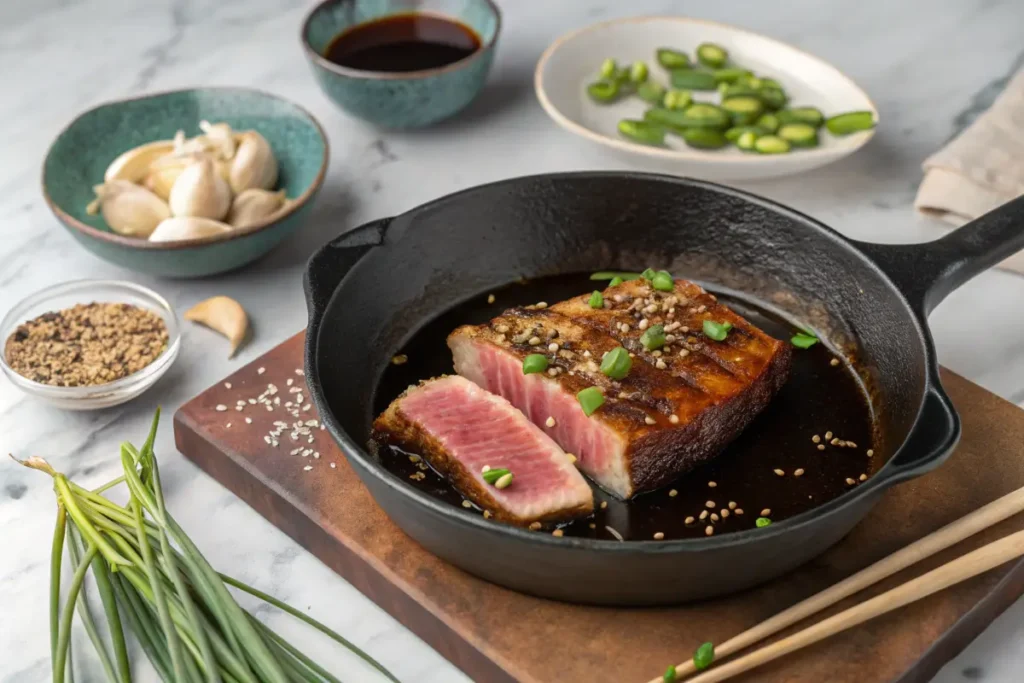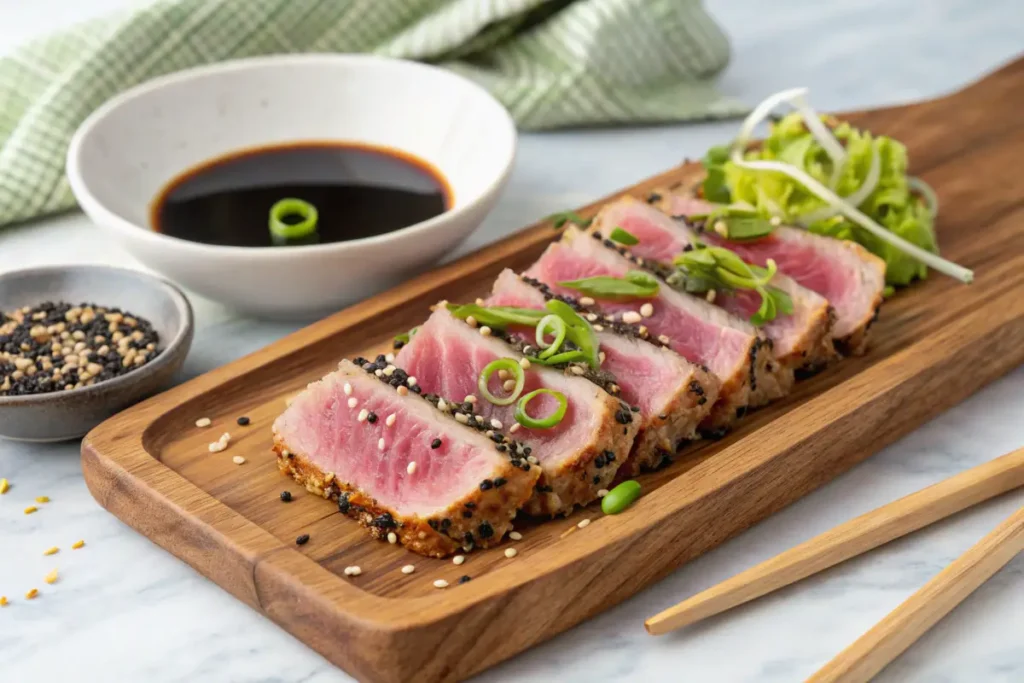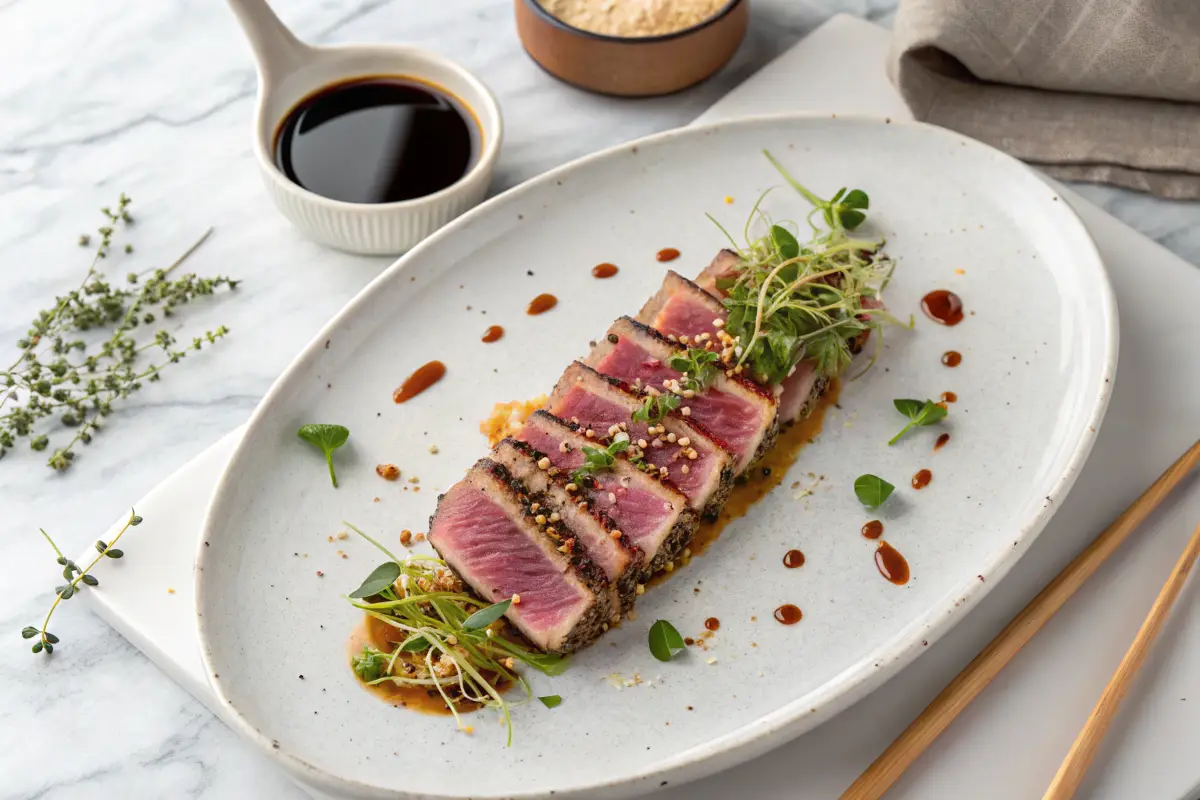If you’ve ever looked at a plate of tataki, you might have wondered: “Wait, is this raw, cooked, or somewhere in between?” It’s not an unusual question, especially if you’re new to Japanese cuisine. Tataki, a delicious blend of raw and cooked elements, is a dish that has puzzled and delighted food lovers for centuries. So, let’s dive into this culinary marvel and uncover its secrets together!
Table of Contents
Introduction to Tataki: A Culinary Art
What Is Tataki?
First things first—what exactly is tataki? Well, tataki is a Japanese cooking technique that involves briefly searing the outside of the meat or fish while keeping the inside mostly raw. Imagine a perfectly charred crust wrapping a tender, almost sashimi-like center. Sounds mouthwatering, right?
Traditionally, tataki is made with either tuna, bonito, or beef, and it’s typically paired with tangy ponzu sauce, grated ginger, garlic, and thinly sliced scallions. The combination creates a beautiful harmony of flavors that’s both refreshing and savory.
“Tataki is the culinary equivalent of walking a tightrope—balancing raw and cooked to perfection.”
Origins of Tataki
The origins of tataki are rooted in Japan’s Shikoku region, specifically in Kochi Prefecture. According to legend, tataki was developed by samurai warriors who wanted a quick way to cook fish without compromising its freshness. The word “tataki” itself means “pounded” in Japanese, referencing the technique of lightly pounding the seared meat to enhance tenderness.
Cultural Significance in Japanese Cuisine
Tataki isn’t just about taste; it’s a dish steeped in tradition. In Japan, food is an art form, and tataki showcases the importance of balance in their cuisine. It reflects the respect for natural flavors and the ability to elevate simple ingredients into something extraordinary.
Tataki Preparation Methods: Raw, Cooked, or Both?
What Makes Tataki Unique?
Let’s get one thing straight—tataki isn’t your typical dish. Its uniqueness lies in its dual nature. It’s not fully raw like sashimi, but it’s not completely cooked like a steak either. The secret? A quick, high-heat sear that gives the surface a smoky, caramelized flavor while leaving the center nearly untouched. This technique creates a contrast of textures and temperatures that’s simply irresistible.
How Is Tataki Traditionally Prepared?

The traditional preparation of tataki is almost like a dance. Here’s how it’s done:
- Searing: The meat or fish is quickly seared over an open flame or hot pan for just a few seconds on each side.
- Cooling: After searing, it’s often plunged into an ice bath to stop the cooking process and lock in the freshness.
- Slicing: The seared protein is sliced into thin pieces, revealing the beautiful contrast between the cooked outer layer and the raw center.
- Seasoning: Finally, it’s seasoned with soy sauce, ponzu, or other zesty toppings to enhance its flavor.
Variations in Tataki Across the World
While traditional tataki stays true to its Japanese roots, chefs around the world have put their own spin on it. For instance, some use exotic spices or sauces like chimichurri to add a global twist. Others experiment with different proteins, such as lamb or duck. No matter the variation, the essence of tataki—its raw and cooked duality—remains intact.
Understanding the Raw and Cooked Debate
Is Tataki Considered Raw?
Here’s the million-dollar question: is tataki raw? The answer is both yes and no. While the inside is indeed raw, the outside is cooked, albeit minimally. This blend of raw and cooked elements is what gives tataki its unique charm.
The Role of Searing in Tataki
Searing is what sets tataki apart from other raw dishes like sashimi or carpaccio. By briefly exposing the protein to intense heat, the outer layer develops a smoky, slightly charred flavor. This technique not only adds depth but also helps eliminate surface bacteria, making it safer to eat.
“Think of searing in tataki as giving a warm hug to the cool, raw interior—it’s all about balance.”
Why Is Tataki Not Fully Cooked?
If you’re wondering why tataki isn’t fully cooked, it’s because the dish is meant to highlight the natural flavors and textures of the protein. Fully cooking it would strip away that delicate, melt-in-your-mouth quality that makes tataki so special.
Common Ingredients in Tataki
Fish and Meat Used in Tataki
The most common proteins for tataki are:
- Tuna: Known for its firm texture and rich flavor, tuna is a tataki favorite.
- Bonito: This slightly oily fish adds a smoky depth to tataki.
- Beef: For meat lovers, beef tataki offers a hearty yet delicate option.
Essential Seasonings and Garnishes
Tataki is all about simplicity. Common seasonings include soy sauce, ponzu, and yuzu juice, while garnishes like grated ginger, garlic, and scallions add a refreshing kick. For an extra burst of flavor, some recipes include toasted sesame seeds or shiso leaves.
Accompaniments to Enhance Flavor
Want to take your tataki experience to the next level? Pair it with a bowl of steamed rice, a side of pickled vegetables, or even a crisp salad. These accompaniments not only complement the flavors but also add variety to your meal.
| Nutrient | Amount |
|---|---|
| Calories | 150 kcal |
| Protein | 25g |
| Fat | 5g |
| Carbohydrates | 0g |
Benefits and Drawbacks of Eating Tataki
Nutritional Benefits of Tataki
Eating tataki isn’t just about pleasing your taste buds—it also packs a nutritional punch. Here’s why:
- High in Protein: Both fish and beef tataki are excellent sources of protein, making them perfect for muscle repair and growth.
- Rich in Omega-3s: If you’re eating tuna or bonito tataki, you’re getting a healthy dose of omega-3 fatty acids, which are great for heart and brain health.
- Low in Calories: Tataki is generally low in calories compared to heavier cooked dishes, making it a light and satisfying choice.
- Loaded with Antioxidants: Ingredients like ginger, garlic, and scallions aren’t just flavorful—they’re also packed with antioxidants to boost your immune system.
“Think of tataki as a guilt-free indulgence—it’s as nutritious as it is delicious.”
Potential Risks and How to Minimize Them
Of course, no dish is without its risks. Since tataki involves raw or partially raw ingredients, there are some things to watch out for:
- Parasites: Raw fish can carry parasites, but using sushi-grade fish helps minimize this risk.
- Bacterial Contamination: Improper handling or storage can lead to bacterial growth, so freshness is key.
- Food Allergies: Some garnishes or sauces might contain allergens, so always check the ingredients if you’re serving guests.
To enjoy tataki safely, always buy high-quality, sushi-grade ingredients and follow proper food safety guidelines. When in doubt, trust your nose—if something smells off, don’t risk it!
Tips for Making Perfect Tataki at Home
Selecting the Right Ingredients
Great tataki starts with great ingredients. Here’s what you need to look for:
- Sushi-Grade Fish or Meat: This is non-negotiable. The quality of your protein will make or break the dish.
- Fresh Herbs: Scallions, cilantro, and shiso leaves should be bright and crisp, not wilted.
- High-Quality Sauce: Choose a premium soy sauce or ponzu for a richer, more complex flavor.
Techniques for Perfect Searing
When it comes to searing, timing is everything. Follow these tips to nail it:
- Use High Heat: You want your pan or grill to be scorching hot—this ensures a quick sear without overcooking the inside.
- Don’t Overdo It: Sear each side for no more than 10–15 seconds. Remember, the goal is to cook just the surface.
- Cool It Down: After searing, plunge the meat or fish into an ice bath to stop the cooking process instantly.
“A good sear is like a first impression—it sets the tone for the entire dish.”
Presentation Tips for Authentic Appeal
Tataki isn’t just a dish; it’s an experience. To wow your guests, presentation is key. Try these ideas:
- Slice Thinly: Use a sharp knife to cut even, thin slices that show off the contrast between the cooked and raw layers.
- Arrange Beautifully: Fan out the slices on a plate, alternating colors if you’re serving multiple types of tataki.
- Garnish Generously: Add a sprinkle of sesame seeds, a drizzle of ponzu, and a scattering of scallions for that final touch.

Popular Tataki Recipes You Can Try
Tuna Tataki Recipe
If you’re craving a classic, tuna tataki is the way to go. Here’s a simple recipe to get you started:
| Ingredient | Quantity |
|---|---|
| Sushi-Grade Tuna | 200g |
| Soy Sauce | 2 tbsp |
| Ponzu Sauce | 2 tbsp |
| Ginger (Grated) | 1 tsp |
| Scallions (Thinly Sliced) | 2 stalks |
| Sesame Oil | 1 tbsp |
Instructions:
- Heat a pan over high heat and add sesame oil.
- Quickly sear the tuna on each side for about 10 seconds. Remove from heat and place in an ice bath.
- Pat the tuna dry and slice thinly.
- Arrange the slices on a plate and drizzle with soy sauce and ponzu.
- Top with grated ginger and scallions. Serve immediately.
Beef Tataki Recipe
For a meaty twist, beef tataki offers a rich, hearty flavor. The process is similar to tuna tataki, but the result is totally different. Here’s what you need:
| Ingredient | Quantity |
|---|---|
| Sushi-Grade Beef (e.g., Tenderloin) | 200g |
| Soy Sauce | 2 tbsp |
| Garlic (Minced) | 1 clove |
| Sesame Seeds | 1 tsp |
| Lemon Juice | 1 tsp |
Instructions:
- Season the beef with salt and pepper. Heat a grill or pan until very hot.
- Sear the beef on all sides for 15–20 seconds. Remove and let it cool.
- Slice the beef thinly and arrange on a plate.
- Drizzle with soy sauce and lemon juice, then sprinkle with sesame seeds and garlic. Enjoy!
How to Enjoy Tataki Safely
Ensuring Freshness and Quality of Ingredients
When it comes to tataki, freshness isn’t just a preference—it’s a necessity. Here are a few tips to ensure your ingredients are top-notch:
- Buy Sushi-Grade: Look for labels that specify “sushi-grade” or “sashimi-grade.” These indicate that the fish or meat is safe for raw consumption.
- Check for Brightness: Fresh fish should have vibrant, translucent flesh, while fresh beef should be deep red and free from discoloration.
- Smell Matters: Fresh seafood should have a mild ocean smell, not a strong or fishy odor.
Storage and Handling Tips
Proper storage and handling are just as important as the quality of the ingredients. Follow these steps to keep your tataki safe to eat:
- Keep fish or meat refrigerated at all times and use it on the same day of purchase.
- Store protein in an airtight container to prevent contamination.
- Sanitize cutting boards and knives before and after use to avoid cross-contamination.
Precautions for Serving Raw Foods
Serving raw or partially cooked food requires extra care, especially if you’re hosting. Here are a few precautions to keep in mind:
- Inform Your Guests: Let them know the dish contains raw elements so they can decide whether to eat it.
- Serve Immediately: Tataki tastes best fresh, so prepare it right before serving to preserve texture and flavor.
- Be Aware of Risks: Pregnant women, young children, and individuals with weakened immune systems should avoid raw dishes.
Conclusion: Celebrating the Art of Tataki
So, is tataki raw or cooked? It’s both—and that’s what makes it so fascinating. This dish is a testament to the creativity of Japanese cuisine, blending raw and cooked elements in a way that’s harmonious, flavorful, and visually stunning. Whether you’re a seasoned foodie or a curious beginner, tataki offers a culinary adventure worth exploring.
Ready to try making tataki at home? Start with fresh, high-quality ingredients, master the quick sear, and let your creativity shine with garnishes and presentation. And if you’re dining out, don’t hesitate to order tataki—it might just become your new favorite dish.
“Tataki isn’t just food; it’s a delicate balance of art and science on your plate.”
FAQs About Tataki
What Is Beef Tataki?
Beef tataki is a Japanese dish made by briefly searing high-quality beef on the outside while leaving the inside mostly raw. The beef is then thinly sliced and served with a tangy dipping sauce, such as ponzu, and garnished with ingredients like scallions, garlic, and sesame seeds. It’s a perfect blend of smoky, savory, and fresh flavors.
Is Beef Tataki Meant to Be Cold?
Yes, beef tataki is typically served chilled or at room temperature. After searing, the meat is often plunged into an ice bath to stop the cooking process, ensuring the interior remains cool and tender. This contrast between the warm seared crust and the cool interior is what makes beef tataki so unique.
Can You Eat Beef Tataki Raw?
Yes, the inside of beef tataki is meant to be raw or very rare. However, to safely enjoy it, you should use high-quality, sushi-grade beef. Proper preparation, including careful searing and immediate cooling, ensures it’s safe to eat while highlighting the natural flavors of the meat.
What Does Tataki Mean?
The term “tataki” translates to “pounded” or “hit” in Japanese. Historically, it referred to lightly pounding or tenderizing the meat or fish after searing to enhance its texture. Today, the word is associated more with the cooking technique of quickly searing the outside while keeping the interior raw.
How Does Tataki Differ From Sashimi?
Tataki involves lightly searing the outer layer of meat or fish before slicing it thinly, while sashimi consists of completely raw, thinly sliced fish or seafood. The addition of a charred, smoky layer is the hallmark of tataki, giving it a different flavor and texture compared to sashimi.
What’s the Best Sauce for Tataki?
Traditionally, tataki is served with ponzu sauce, a citrusy soy-based condiment. Some variations include soy sauce mixed with grated ginger, garlic, or yuzu juice for added zest. The sauce enhances the natural flavors of the protein without overpowering it.
Is Tataki Safe for Pregnant Women?
Because tataki includes raw or partially raw fish or meat, it is generally not recommended for pregnant women. Raw proteins carry a risk of harmful bacteria or parasites, which can be dangerous during pregnancy. If you’re expecting, consult your doctor before consuming raw dishes.
Why Is Tataki Sliced Thinly?
Thin slicing makes tataki easier to eat and ensures that each bite captures the perfect balance of the seared crust, tender raw center, and garnishes. This presentation also makes it visually appealing, showcasing the contrast between the cooked and raw layers.
